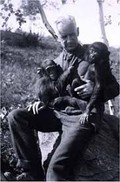Yerkes Laboratories of Primate Biology
Introduction
Text-to-speech Audio
Images
Dr. Yerkes holding two of his first chimpanzees, named Chim and Panzee

Primates are gathered in their outdoor enclosure with jungle gym.

Yerkes Laboratories of Primate Biology at Emory University

Backstory and Context
Text-to-speech Audio
The Yerkes Laboritories of Primate Biology was founded in 1930 by Dr. Robert M. Yerkes and funded in part by Yale University. He wanted to study primates because of their evolutionary similarities to humans. His original goal was to study and do experiments on the primates to develop better medical practices for humans. He wanted to research the fundamental instincts and social relations of primates.
The first chimpanzee colony at the Laboratory included 33 chimpanzees. With the Laboratory's first chimpanzee, it gave scientists the first detailed observation of chimpanzee reproduction, growth, and development. Since then, the laboratory has raised thousands of chimpanzees and made significant advances in medicine. One example is the polio vaccine. It was developed directly due to primate research.
In 1942, Dr. Yerkes retired from the Laboratory and the name was officially changed to what it is now, The Yerkes Laboratory of Primate Biology to honor his contributions to primate research. Following his death in 1956, Yale University decided to transfer the ownership of the Laboratory to Emory University where it still remains. In 1961, the Yerkes Laboratory was granted the National Institute of Health's Regional Primate Research Center status. By 2002, the NIH named Yerkes Laboratory a National Primate Research Center to recognize its impact on medicine and other research programs.
In 1963, Emory University made the decision to move the Laboratory to their Druid Hills campus in Georgia. Since being in Georgia, the Laboratory has experienced many improvements. A vaccine center, a neuroscience research facility, and many expansions were added.
The Yerkes Laboratory of Primate Biology is currently still operating and located in Georgia. They still work to improve human and animal health. They now have over 3,000 nonhuman primates of many kinds as well as 8,000 rodents. With Yerkes' Behavioral Management program, the psychological health of all their primates is taken care of. The animals are treated with quality care to ensure their well-being and health.
Sources
Emory University. History, Yerkes National Primate Research Center. Accessed February 28th 2021. http://www.yerkes.emory.edu/about/index.html
This source is from the Emory University website, specifically the Yerkes National Primate Research Center's webpage. This source goes into detail about the history, goals, activities, and research done by the Center. It explains the origin of the Center as well as information about the founder, Dr. Robert M. Yerkes. This site is up to date and well-organized. It is a credible source that is used to learn more about the Center and its history.
The Yerkes Laboratory, The First 100 Chimpanzees. Accessed February 28thAl 2021. http://first100chimps.wesleyan.edu/yerkes.html
This source is about the first Chimpanzees that were studied at the Yerkes National Primate Research Center. It details specific dates when chimpanzees were purchased, big events, as well as the opening of the laboratory and how it has changed throughout history. This source is important because it helps to understand the early days of the Center and how it got started. It also discusses more about Dr. Robert M. Yerkes, the founder of the Center.
http://www.yerkes.emory.edu/about/history.html
http://www.yerkes.emory.edu/
http://www.yerkes.emory.edu/about/index.html
